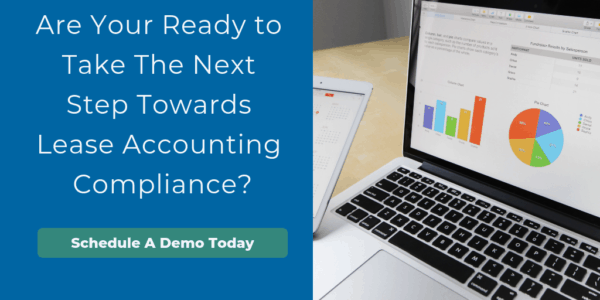
- What is lease management?
- What are lease management tasks?
- Who is responsible for lease administration?
- How can you optimize your lease management strategy?
- Why is lease management important?
- Lease Management Software
Until recently, many companies were not paying much attention to their property and asset leases beyond paying the bills. Leases were simply considered a cost of doing business, and managing lease terms and obligations was not a priority.
With the establishment of new lease accounting standards that take effect for private companies in 2021, and took effect for public companies in 2019, that mindset is changing fast. Lease management has now become an essential practice that impacts financial reporting and the bottom line.
If your organization is working toward FASB/IFRS compliance, you’ll need to establish lease management policies and procedures. Below, we dive into why now is the best time to do it and how to create a streamlined lease management process flow.
What is lease management?
In a corporate or non-profit organization, lease management means tracking and optimizing every aspect of your portfolio of leased assets. Properly tracking leases (not only real estate but also technology, vehicles, and even assets you control as part of service agreements) can help you significantly reduce the expenses associated with leasing. We’re not talking about small change here, but a chance to add millions to your bottom line.
What are lease management tasks?
Lease administration requires a coordinated effort between the various teams performing these tasks:
- Lease negotiation and decision making, including lease structure, lease length, and lease-vs-buy options
- Lease tracking tasks, such as keeping track of upcoming renewals and exercising options, managing operating expenses, and updating lease data
- Lease accounting tasks, including payment of lease-related charges, recording journal entries, calculating asset and liability figures, generating reports, and performing remeasurement when leases change
What is a lease management system?
A lease management system is a software solution designed to streamline and automate the management of lease agreements throughout their lifecycle. It helps organizations efficiently handle the tasks and processes associated with leases, such as tracking lease details, monitoring key dates, generating reports, and ensuring compliance with lease terms and regulations.
Where does responsibility for lease administration sit within an organization?
Depending upon an organization’s size, lease administration can be cross-functional, spread across various departments such as accounting, real estate, legal and procurement, or handled by a single dedicated resource within any of these departments.
Companies that have a significant concentration of a specific asset type, like real estate, will most likely have an individual or even an entire department dedicated to the management of those leases. Further, with real estate leases, it is not uncommon for companies to outsource all or some portion of its real estate lease administration to a third-party broker or company. This same concept applies to other lease types, including fleet and IT equipment.
How can you optimize your lease management strategy?
Why has lease management process flow become so important? Under the old lease accounting rules, leases were not included on balance sheets and had little impact on financial reporting. Under the updated lease accounting standards, organizations must record both right-of-use assets and payment liabilities associated with leases on their balance sheets.
This is a big change: adding the value of the entire leased portfolio can make a huge impact on the outcome of financial reports. It also means the risks associated with poor lease decisions and management are magnified. That’s why financial leaders must now carefully scrutinize and manage leasing decisions, administration practices, and expenses.
Before you make the move to the newest standards, here’s how to get everyone on the same page and your lease management process flow in order.
How to establish a cross-functional lease tracking process
In the past, lease negotiation, administration, and accounting were done in silos with little to no coordination between the teams handling each task. That led to inconsistent lease decisions, scattered data, and often, overpayment of lease expenses due to lack of centralized records and audit capabilities.
An effective lease management process flow requires cross-functional collaboration as well as centralized access to lease data and lease management tools.
STEP 1: Centralize lease data and management tools
For teams to work together on lease tracking, the first step is to gather all lease data in a central repository that creates a single source of truth as well as an audit trail for all lease decisions and changes.
Chances are, you’re in the process of centralizing lease payment data for FASB/IFRS compliance right now. To set your teams up for effective lease management process flow, choose a lease management software platform (like Visual Lease) that allows you to centralize ALL data related to lease contracts and provides tools for automating lease tracking tasks and auditing expenses.
When everyone managing leased assets is using the same system to update lease data, schedule payments, and create accounting journal entries, everyone is always working with the most current data. And you eliminate data integrity problems that can occur when data is moved between systems.
STEP 2: Develop leasing policies
With centralized tracking tools and technology in place, you can now analyze your lease data and find out which leases are working well and which are costing you more money than you realized. Use those insights to determine how you want to standardize leasing decisions across the organization.
Best practice is for financial leaders to work with lease negotiators, administrators, and accountants to understand current practices and to establish cost-effective policies for leasing.
STEP 3: Create lease requisition and update processes
To ensure your accounting team always has accurate lease information to feed balance sheets and financial reports, it’s essential to establish standard practices for every group that’s involved in acquiring and maintaining leases, including processing new leases, documenting lease changes, and handling lease terminations.
Here’s what you might not know if you’re still in the process of consolidating lease data for FASB ASC 842 implementation: every time leases change, your accounting must be updated. So, it’s smart to minimize the burden on your accounting team by choosing lease accounting software that automates lease modification and re-measurement.
STEP 4: Set up controls
Adding leases to the balance sheet has increased the complexity of financial reporting. That means more oversight is needed to ensure accounting accuracy. Also, internal monitoring and process validation are required to ensure your policies and procedures are being followed and are driving better decisions and reduced expenses.
Your lease management software can aid that process in several important ways:
- Documenting the terms of every lease, calculating every payment, and alerting you if payments don’t match the lease terms
- Providing audit tools to find overpayments, late fees, and payments that shouldn’t have been made at all
- Allowing you to customize approvals required for lease administration and lease accounting tasks
- Providing an audit trail for all lease changes
Why is lease management important?
Lease management is critically important to ensure your business remains confident in sustaining lease accounting compliance.
Tackle lease tracking along with the lease accounting changes
Leases are ever-changing. Terms are constantly modified as businesses renegotiate their lease contracts, take on new spaces or terminate their leases.
Under the new lease accounting standards (ASC 842, IFRS 16 and GASB 87), each of these modifications must be accounted for.
Lease management software provides businesses with a single source of truth to easily view and access your leases.
What are the benefits of lease management?
Lease management offers several benefits for organizations that have a portfolio of leased assets. Here are some key advantages:
- Improved efficiency and time savings
- Enhanced visibility and control over lease portfolio
- Cost savings through optimized lease terms and space utilization
- Compliance with lease accounting standards (ASC 842, IFRS 16)
- Streamlined reporting and analytics for informed decision-making
- Better collaboration and communication among stakeholders
- Reduced risks of penalties and non-compliance
- Proactive management of lease renewals and important dates
- Minimized manual effort and administrative tasks
- Data-driven insights for strategic planning and portfolio optimization.
Lease Administration Software
Your lease management software can aid the process in several important ways:
- Documenting the terms of every lease, calculating every payment, and alerting you if payments don’t match the lease terms
- Providing audit tools to find overpayments, late fees, and payments that shouldn’t have been made at all
- Allowing you to customize approvals required for lease administration and lease accounting tasks
- Providing an audit trail for all lease changes
FASB recently voted to extend the deadline for private companies to implement the new standards to December 15, 2021, and chances are you are breathing a sigh of relief. However, don’t make the mistake of underestimating the effort and putting off the problem. Instead, take this opportunity to examine and overhaul your lease management policies and process flow while you’re working toward lease accounting compliance.
























